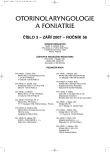Automatic Recognition of the Speech and Possibilities of Application in Hearing Disorders
Authors:
O. Vyšata 1; A. Procházka 2; J. Kukal 2; P. Bečvárovský 3; M. Kučera 4; L. Pazdera 1
Authors‘ workplace:
Centrum neurologické péče, Rychnov nad Kněžnou
1; Vysoká škola chemicko-technologická, Ústav počítačové a řídicí techniky, Praha
2; VMR s r. o., Praha
3; ORL ambulance, Rychnov nad Kněžnou
4
Published in:
Otorinolaryngol Foniatr, 56, 2007, No. 3, pp. 144-148.
Category:
Original Article
Overview
Algorithms for artificial speech recognition may be useful in presentation of auditory stimuli by somatosensory stimulation in profoundly or severely deaf people. Recognized text my be presented on special glasses or electrotactile stimulators. Multichannel electrocutaneous or pulsatile stimulation is essential for tactile presentation of recognized characters in sensory substitution through the sense of touch on the trunk. In this pilot study, a system for multichannel electrotactile stimulation is presented for studying carbon electrodes placed on inert flexible membrane. The system utilized an array of 3x8 or 4x8 stimulators, each of them representing one character. Initial testing of electrotactile character presentation was performed in human subject. Efficiency of artificial speech recognition algorithms and speed of character recognition on the trunk allow good understanding of subject matter.The testing results suggested that this promising method may allow speech recognition by deaf people in real time.
Key words:
hearing prosthesis, somatosensory analyzer, automatic speech recognition.
Sources
1. Haase, S. J., Kaczmarek K. A.: Electrotactile perception of scatterplots on the fingertips and abdomen. Med. Biol. Eng. Comput., roč. 43, 2005, č. 2, s. 283-239.
2. Hallum, L. E., Dagnelie, G., Suaning, G. J., Lovell, N. H.: Simulating auditory and visual sensorineural prostheses: a comparative review. J. Neural. Eng., roč. 4, 2007, č. 1, s. 58-71.
3. Middlebrooks, J. C., Snyder, R. L.: Auditory prosthesis with a penetrating nerve array. J. Assoc. Res. Otolaryngol, roč. 30, 2007.
4. Perez, C. A., Santibanez, A. J., Holzmann, C. A., Estevez, P.A., Held, C. M.: Power requirements for vibrotactile piezo-electric and electromechanical transducers. Med. Biol. Eng. Comput., roč. 41, 2003, č. 6, s. 718-726.
5. Shim, J. W., Liu, W., Tang, H.: System development for multichannel electrotactile stimulation on the lips. Med. Eng. Phys., roč. 28, 2006, č. 7, s. 734-739.
Labels
Audiology Paediatric ENT ENT (Otorhinolaryngology)Article was published in
Otorhinolaryngology and Phoniatrics

2007 Issue 3
Most read in this issue
- Clinical Problems of Hypopharygeal Carcinomas
- Stenoses of Trachea after Cannulation
- Profiloplasty of Rhinoplasty
- Using Cartilage Grafts by Retraktion Pockets by Children
